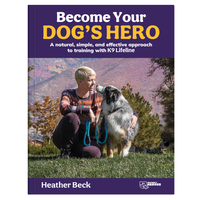The Beginner's Guide to Crate Training Your Dog

At Heather's Heroes, we're passionate about helping you become your dog's hero — strengthening the bond between you and your furry companion with simple, empowering training.
Crate training is one of the most valuable tools you can use to create calm, confidence, and trust. In this guide, we'll walk you through everything you need to know to set your dog (and yourself!) up for success.
Why Crate Training Matters: The Power of a Safe Place
Crate training isn't just about management — it's about teaching calm, providing security, and creating a structured space where your dog can reset and relax.
Here’s what mastering crate training can unlock for you and your dog:
-
Security and Comfort: A crate offers a den-like retreat where your dog can decompress and feel safe, especially during stressful times or when home alone.
-
Faster House Training: Crates build natural bladder control, making potty training smoother and faster.
-
Prevention of Destructive Behaviors: A calm mind inside the crate translates to better decision-making outside of it.
-
Safe and Stress-Free Travel: Crate-trained dogs ride calmly and securely, making every trip safer and easier.
-
Confidence and Independence: Crate time helps dogs learn to self-soothe, a critical life skill for happy, well-adjusted dogs.
-
Strengthened Bond: Structure builds trust — and trust builds the kind of relationship every dog and owner dreams of.
How to Crate Train the Heather's Heroes Way

Crate training is like building a superpower — it's all about small, consistent wins. Here’s how to do it:
1. Choose the Right Crate
Pick a size that allows your dog to stand, turn around, and lie down comfortably.
Wire crates offer visibility and airflow, while enclosed crates create a cozier, den-like vibe. Choose the style that best suits your dog’s personality.
2. Build it Into the Routine
Use the crate during mealtimes, nap times, and for scheduled relaxation periods. Crate time = Calm time.
3. Never Use It for Punishment
The crate is your dog’s calm zone — not a consequence.
If misbehavior happens, correct it outside of crate time and keep the crate a sanctuary.
4. Balance is Key
While crate time is crucial for teaching downtime, it’s equally important to provide exercise, enrichment, and bonding time outside of the crate.
Crate Training FAQs
How long can I leave my dog in the crate?
Adult dogs can stay in the crate the course of a workday, but need plenty of quality time out of the crate when you are home. Puppies need about 18-20hrs or rest a day do they need more down time and shorter quality time when out.
Should I cover the crate?
If it helps your dog relax, absolutely! Some dogs love the cave-like feel of a covered crate; others prefer open visibility. Let your dog’s behavior guide you.
Can I crate train an older dog?
Yes! It might take a little more time and patience, but every dog can learn to love their calm space.
What if my dog whines in the crate?
Stay patient. Make sure your providing quality time activities for your dog outside of the crate so they learn to rest while in it. It usually takes about 3 days of a good rest routine for the dog to learn to settle.
Your Next Step: Become Your Dog’s Hero
Mastering crate training is the first step toward a calmer, more connected life with your dog.
For more expert strategies — from leash work to emotional regulation — join us inside the "Become Your Dog’s Hero" online course.
Together, we'll unlock the full potential of your bond, turning everyday moments into heroic adventures.
Sign up here to start your journey.








Leave a comment